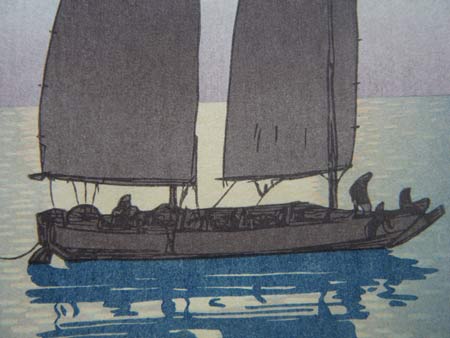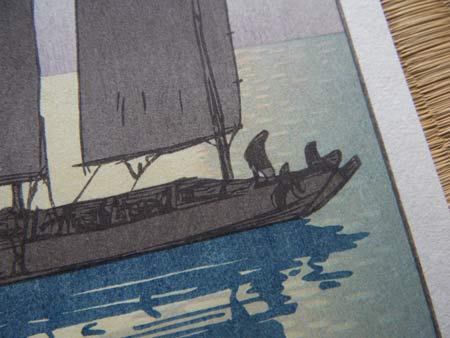Traditional Sailing Boat (帆船) Designer: Hiroshi Yoshida | Carver: David Bull | Printer: Kenichi Kubota Paper size: 23cm by 13.8cm | Enlargement | Shipping Code: [M] ? ( Change currency: $ / £ / € ) Price: $ 80.00£ 60.75€ 69.00   Description: This print was included by David in his original Surimono Album (2), published back in 2000. That set is now (nearly) out of print, so the blocks are being used to make issues for the Mokuhankan catalogue. This version has been printed by Mr. Kenichi Kubota, one of Japan's top freelance printers. (This is one of a matching pair that appear in our Mokuhankan catalogue. We also have the 'Night' view of the same design, and we offer a discounted price on the purchase of the pair together.) To introduce this print, perhaps it is easiest to quote the small story written by David for inclusion with the print in the original series: "This is the first time in these Surimono Albums that I have included a print from the 20th century. This image was created by Hiroshi Yoshida, and the print is from his book Japanese Woodblock Printmaking, published in Tokyo - in English - in 1939. I am able to include it here because Mr. Yoshida's copyright has now expired; he passed away in the spring of 1950, so his life work fell into the public domain just a couple of weeks ago, on the last day of 2000. "When I make reproductions of Edo-era prints, I never have any feeling that I am 'stealing' another man's work. After hundreds of years have passed, nobody 'owns' an image; it becomes part of our common cultural heritage. But with an image from the recent past like this one, even though I am legally permitted to make this reproduction, I must confess to a certain feeling that I am trespassing in a place where I shouldn't be. So I have made one change to the design - I have omitted his carved signature and seal; to reproduce those would have felt improper to me. (I should also mention that in order to avoid any possible charge of 'forgery', I have made my print at a slightly increased size from the original. There can thus be no doubt that it is not an 'original' Yoshida.) "I owe quite a debt to Mr. Yoshida and his family. He had a very strong desire to see that the traditional Japanese printmaking technique would be not only preserved, but spread around the world. In his book he speaks of "... helping me to realize my long-cherished desire to let this peculiarly Japanese art become better known in the West." and "... through the medium of this book, make (my) experience and knowledge available to all who may care to profit by it." And he certainly did; the book is an absolute treasure-house of information on printmaking. He kept no 'secrets', and one turns the pages in wonder at the amount of information that is crammed into the book. But who did he write it for? Did he expect people around the world to pick up tools and start to make woodblock prints? His book did not actually make much of an impact on printmaking in other countries; his timing was most unfortunate ... 1939 and the years following it were not the best of times for Japan/Western relations. But after the war Mr. Yoshida's son Toshi took up the same mission - spreading knowledge of Japanese printmaking around the world. He opened the 'Yoshida Studio' - a facility to which anybody could come and learn about printmaking. I myself was a beneficiary of their teachings, spending a few months in the fall of 1986 working in the studio. I should have stayed much longer, as I could have learned a great deal from Komatsu-san, the senior printer working there, but I rather stupidly felt that I wanted to 'go it alone'. "So given this background, I am in no way worried that the late Mr. Yoshida would feel that I am 'stealing' his design. I think that even though he passed away before I was born, I am perhaps one of his 'star' students, for I too am carrying on the same work that he pursued so intensely - spreading knowledge of this craft around the world. I have sponsored the publication of his book on the internet, where it is freely available for anyone to read, and it has been 'downloaded' by many hundreds of people who are studying the information in it. And there is one more thing that I must add to this tale ... although this print is very different in construction from the ukiyo-e work with which I am most familiar, I had a very good guide to 'hold my hand' through the work. Mr. Yoshida went to the great trouble and enormous expense of including in his book hand-printed progressive proofs of every stage in the process of making this print. 'All' I had to do was follow the step-by-step instructions! "Thank you very much to Mr. Yoshida, his son Toshi, and to his grandson Tsukasa, who now carries on the family printmaking tradition. To their openness and willingness to share their knowledge, many people around the world owe a great deal. I am pleased to be able to play a small part in helping their work reach a wider audience."rn    Browse thumbnail pages of various selections from the catalogue ... Mokuhankan Publications:general (104) kacho-e (27) landscape (54) bijin-ga (19) contemporary (17) senshafuda (2) yakusha-e (4) HangaClub (70) ebook (6) miscellaneous (4) 8 Cats (4) supplies (6) [ Also see our Annual Gift Page ] Partner Shops: Kawase Hasui prints (14) Yoshida family prints (52) Doi Hanga prints (15) Miyakodori prints (11) Numabe Mokuhan prints (3) Guest items (17) Mokuhankan Flea Market (All items) general (68) kacho-e (38) yakusha-e (24) landscape (131) bijin-ga (87) kuchi-e (2) contemporary (4) set (43) books (4) (Recently sold items) |
||

